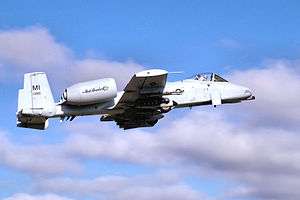107th Fighter Squadron
Coordinates: 42°37′36.5″N 82°50′41.6″W / 42.626806°N 82.844889°W
| 107th Fighter Squadron | |
|---|---|
|
A-10 Thunderbolt II 80-255 | |
| Active | 27 August 1917–present |
| Country |
|
| Allegiance |
|
| Branch |
|
| Type | Squadron |
| Role | Close Air Support |
| Part of |
Air Combat Command Michigan Air National Guard |
| Garrison/HQ | Selfridge Air National Guard Base, Mount Clemens, Michigan |
| Nickname(s) | "Red Devils" |
| Motto(s) | "Mors Hostibus" |
| Tail Code | "Selfridge" in black letters; "MI" |
| Engagements |
World War II Korean War Operation Desert Storm Operation Northern Watch Operation Southern Watch Operation Iraqi Freedom |
| Decorations |
|
| Insignia | |
| 107th Fighter Squadron emblem |
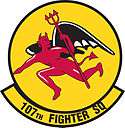 |
The 107th Fighter Squadron (107 FS) is a unit of the Michigan Air National Guard 127th Wing. It is assigned to Selfridge Air National Guard Base, Michigan and is equipped with the Fairchild Republic A-10 Thunderbolt II aircraft.
The squadron is a descendant organization of the World War I 107th Aero Squadron, established on 27 August 1917. It was reformed on 7 May 1926, as the 107th Observation Squadron, and is one of the 29 original National Guard Observation Squadrons of the United States Army National Guard formed before World War II.
History
World War I
The 107th Fighter Squadron traces its origins to 26 August 1917 with the organization of the 107th Aero Squadron. Forty recruits arrived at Kelly Field, San Antonio, Texas from Vancouver Barracks, Washington. An additional 341 recruits arrived from Fort Thomas, Kentucky, and 110 men and along with the 40 from Vancouver were formed as the 107th. The squadron was initially indoctrinated into military service, performing drill, fatigue duties and also construction work at the field. Once basic indoctrination training was completed, the 107th was ordered for overseas duty, being ordered to report to the Aviation Concentration Center, Garden City, Long Island on 26 October. It was there that final arrangements were made for the trip overseas, complete equipment was drawn and a final few transfers were made.[1]
On 7 December, the 107th was ordered to proceed by train to St. John's, Newfoundland. On the 10th it boarded the SS Tuscania for the cross-Atlantic voyage, arriving on Christmas Morning at Liverpool, England. After a brief rest, the squadron arrived at Southampton, England on the 29th, and crossed the English Channel to Le Havre, France. There, it then traveled by train to the Replacement Concentration Center, AEF, St. Maixent Replacement Barracks, France, arriving on 2 January 1918. At St. Maixent the squadron was re-designated as the 801st Aero Squadron, and placed on camp duty for nearly two months. Finally, it was ordered to proceed to the 3d Air Instructional Center (3d AIC), Issoudun Aerodrome, in Central France, arriving on 21 February. Initially the squadron was assigned to the main airfield, working in the aircraft assembly and test departments. On 7 June, help was needed at Field #2, and the 801st was ordered to send 100 men to help put the field in better shape. Cooperating with another squadron, Field #2 was placed on an efficient basis as any field in the AEF.[1]
The squadron remained at 3d AIC until after the Armistice with Germany in November 1918, then returned to the United States in March 1919. Arrived at Mitchel Field where the squadron members were demobilized and returned to civilian life.[1][2]
Intra-War period
After the war the squadron was reorganized in 1925 as the Michigan National Guard's first flying unit, the squadron consisted of 20 officers and 90 enlisted men meeting weekly in a Detroit garage. It received Federal recognition in May 1926 as the "Air Section" of the Michigan National Guard's 32nd Division. Its primary mission was artillery spotting and observation of troop movements.[3]
In March 1938, elements of the 107th Observation Squadron performed gunnery training at Eglin Field, Florida, for fifteen days, deploying from Wayne County Airport at Detroit, Michigan. Twenty-three officers and 111 men arrived on 1 March. One detachment flew in eight aircraft while the rest arrived by rail over the Louisville and Nashville Railroad at Crestview, Florida.[4]
World War II
Called to active duty with Douglas O-38 and North American O-47 observation planes on 15 October 1940, the 107th was sent to the airfield at Camp Beauregard, Louisiana for unit training on 28 October 1940. For many years this airfield was simply called the Artillery Range Airport Camp.
On 11 April 1941, Lieutenant Wilmer Esler was killed in the crash of his O-47 when it experienced an engine failure on take off.[5] The War Department announced on 19 June 1941 that the Air Corps field at Camp Beauregard would be named Esler Field in honor of his sacrifice.[6]
In 1941, the 107th was joined by two other National Guard observation units to form the 67th Observation Group. The 67th Group did anti-submarine patrolling off the East Coast of the US from mid-December 1941 to March 1942, when it returned to Louisiana for training in fighter aircraft.
The 67th Group was sent to Membury, England, in August 1942 and flew Mk V Spitfires and Tiger Moths for a year until equipped with F-6A's. Pre-invasion missions began in December 1943. For successful photo missions of the French invasion coastline without loss of a single aircraft, the 107th was awarded the Presidential Unit Citation on 7 April 1945. The 67th Group advance detachments landed in Normandy 13 days after D-Day. The Belgian Fourragere was awarded for conspicuous action during the Battle of the Bulge.
Michigan Air National Guard
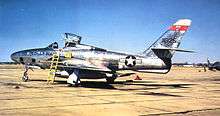

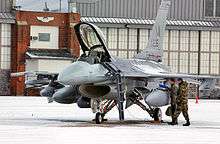
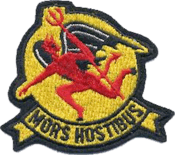
The wartime 107th Tactical Reconnaissance Squadron was re-designated as the 107th Bombardment Squadron (Light), and was allotted to the Michigan Air National Guard, on 24 May 1946. It was organized at Wayne City Airport, Michigan and was extended federal recognition on 9 June 1948. It was assigned to the newly organized Michigan Air National Guard's 127th Fighter Group. The 107th Bombardment Squadron was entitled to the history, honors, and colors of the previous 107th organizations. The squadron was equipped with F-51H Mustang, and was allocated to the Tenth Air Force, Continental Air Command by the National Guard Bureau.
In 1950, the unit was converted to F-84B & C jets and on 1 February 1951, the unit was activated as part of the 127th Pilot Training Group stationed at Luke AFB. The 107th returned to Michigan in November 1952.
F-16s from the 107th Fighter Squadron deployed to Kirkuk in February 2004 to replace the 354th Fighter Squadron. The 107th became the first F-16 unit to be based in Iraq. It was stationed at Kirkuk Air Base. The unit returned home in early June 2004.
As a result of the 2005 Base Realignment and Closure decision, the 107th will be converting from the F-16 to the A-10 Thunderbolt II.[7] The 107th flew its last sortie with F-16s on 16 December 2008. The three remaining F-16s on the base are scheduled to be transferred to Fort Wayne Air National Guard Base in Indiana, and twenty-four A-10s are scheduled to arrive at Selfridge in May 2009.[8]
Distinguished Members
Among the distinguished former members of the 107th Fighter Squadron is former World War II 361st Fighter Group ace Urban "Ben" Drew, who was a F-51 instructor pilot assigned to the 107th Fighter Squadron in Detroit from 1947 to 1950. During World War II, while flying a P-51 named "Detroit Miss" Lt. Drew was credited with being the only pilot to shoot down two German Me 262 jet fighters on a single mission. He was also credited with destroying the sole German BV 238 seaplane, the largest aircraft to see service during World War II.
Lineage
- Organized as 107th Aero Squadron** on 27 August 1917
- Re-designated: 801st Aero Squadron on 1 Feb 1918
- Re-designated: 801st Aero Squadron (Repair) on 21 Feb 1918
- Demobilized on 18 Mar 1919
- Reconstituted and consolidated (1936) with 107th Observation Squadron which, having been allotted to the Michigan NG, was activated on 7 May 1926
- Ordered to active service on 15 Oct 1940
- Re-designated: 107th Observation Squadron (Light) on 13 Jan 1942
- Re-designated: 107th Observation Squadron on 4 Jul 1942
- Re-designated: 107th Reconnaissance Squadron (Fighter) on 31 May 1943;
- Re-designated: 107th Tactical Reconnaissance Squadron on 13 Nov 1943
- Inactivated on 9 Nov 1945
- Re-designated 107th Bombardment Squadron (Light), and allotted to Michigan ANG, on 24 May 1946
- Ordered into active service on 1 Feb 1951
- Re-designated: 107th Pilot Training Squadron on 1 Feb 1951
- Relieved from active duty and returned to Michigan ANG, on 1 Nov 1952
- Re-designated: 107th Fighter-Bomber Squadron, 1 November 1952
- Re-designated: 107th Fighter-Interceptor Squadron, 1 November 1953
- Re-designated: 107th Tactical Reconnaissance Squadron, 1 July 1958
- Re-designated: 107th Tactical Fighter Squadron, 1 July 1972
- Re-designated: 107th Fighter Squadron, 15 March 1992
** This unit is not related to another 107th Aero Squadron (Service) that was activated in March 1918 at Rich Field, Waco, Texas.
Assignments
- Post Headquarters, Kelly Field, 27 August-31 October 1917
- Aviation Concentration Center, 31 October-7 December 1917
- Replacement Concentration Center, AEF, 2 January-21 February 1918
- 3d Aviation Instruction Center, 21 February 1918 – 4 January 1919
- Commanding General, Services of Supply, 4 January-8 March 1919
- Eastern Department, 8-18 Mar 1919
- Michigan NG (divisional aviation, 32d Division), 7 May 1926
- Fourth Corps Area 15 Oct 1940
- V Army Corps, c. Dec 1940
- 67th Observation (later Reconnaissance; Tactical Reconnaissance) Group, 1 Sep 1941-9 Nov 1945
- 127th Fighter Group, (many designations), 29 Sep 1946–Present
Stations
|
|
Aircraft
|
|
See also
References
![]() This article incorporates public domain material from the Air Force Historical Research Agency website http://www.afhra.af.mil/.
This article incorporates public domain material from the Air Force Historical Research Agency website http://www.afhra.af.mil/.
- 1 2 3 Series "E", Volume 25, History of the 800th-1111th Aero Squadrons. Gorrell's History of the American Expeditionary Forces Air Service, 1917–1919, National Archives, Washington, D.C.
- ↑ Order of Battle of the United States Land Forces in the First World War, Volume 3, Part 3, Center of Military History, United States Army, 1949 (1988 Reprint)
- ↑ Order of Battle : 107th FS Michigan Air National Guard
- ↑ Crestview, Florida, "Aerial Squadron Flies Eight Planes To Val-P For Gunnery Practice", Okaloosa News-Journal, Crestview, Florida, Friday 4 March 1938, Volume 24, Number 10, page 6.
- ↑ "April 1941 USAAF Accident Reports". Aviation Archaeological Investigation and Research. Retrieved 9 January 2007.
- ↑ "Louisiana Maneuver Camps and Bases". Louisiana: World Renown Involvement in World War II. Louisiana Department of Culture, Recreation and Tourism. Archived from the original on 7 December 2008. Retrieved 9 January 2007.
- ↑ "Red Devils Return to Michigan." Press Release. Michigan.gov. Accessed: 4 November 2007. New Page 2
- ↑ "F-16s fly away from Selfridge" Chad Selweski, Macomb Daily. Accessed: 19 December 20087. F-16s fly away from Selfridge - macombdaily.com
- ↑ William J Brenell (Spring 2004). "The Known North American O-47 Assigned to Pre-World War II Air National Guard Squadrons". AAHS journal.
